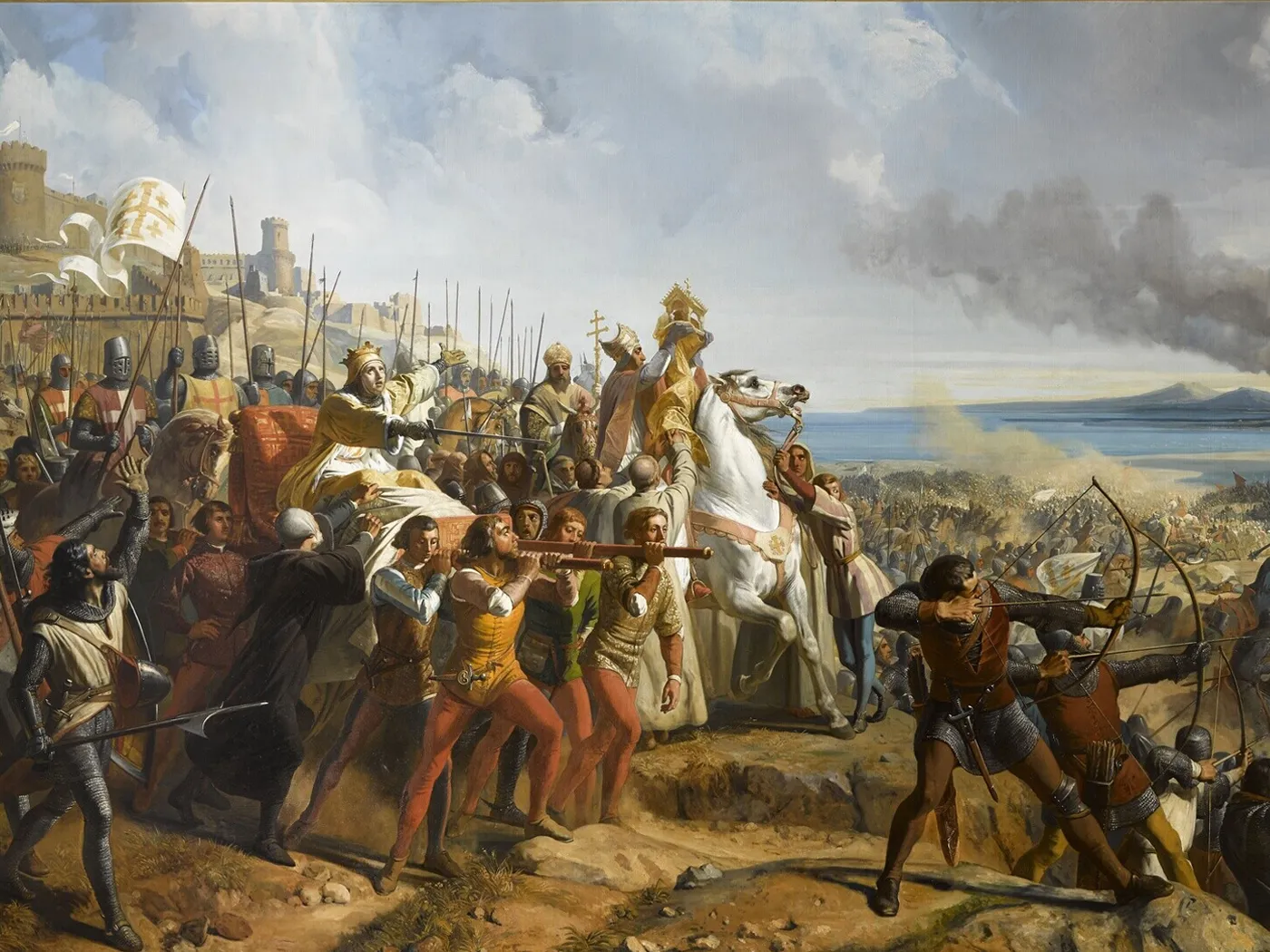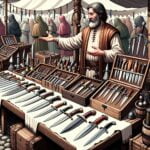Get ready for a wild audio tour of the Crusades, where we’ll dive into the thrilling highs and lows of medieval Europe. “Unveiling the Past” will take you back in time to explore the why’s, the what’s, and the epic aftermath of these epic wars. We’ll dig into the religious passion, the clash of swords, and the mind-blowing cultural exchanges that shaped the Crusades. Whether you’re a history buff or just curious to learn about this crazy time, strap in and let’s uncover the mysteries of one of the most fascinating chapters in human history.
History of the Crusades Podcast
Want to dive deep into the dramatic and often misunderstood world of the Crusades? Then you need to check out the History of the Crusades Podcast! This isn’t your typical dry history lecture – it’s a captivating journey through time, led by the expert voice of historian Sharyn Eastaugh.
This podcast isn’t just about battles and conquests, though there were plenty of those. It’s about understanding the complex web of relationships between Christians, Muslims, and other groups who were caught up in this tumultuous period. You’ll hear voices from multiple sides of the conflicts, getting a much more balanced and nuanced perspective than you might find in a textbook.
What makes this podcast really stand out is its commitment to accuracy and depth. Sharyn doesn’t just rely on one or two sources – she digs into a treasure trove of historical documents, including firsthand accounts from the time, detailed chronicles, and the latest interpretations from leading scholars.
But it gets even better! The podcast also provides some really cool extras, like interactive maps that let you visualize the Crusades’ geographic reach and the specific routes taken during different campaigns. Plus, you’ll find supplementary materials that help deepen your understanding even further. And the best part? You can listen to episodes anytime, anywhere, on a variety of platforms.
What truly sets this podcast apart is its sense of community. It’s not just a one-way street of information – it’s a chance to connect with other history buffs just like you! Through the podcast’s active social media presence, you can chat with Sharyn, ask questions, share your thoughts, and dive into discussions about the Crusades.
So, if you’re ready to journey back in time and unravel the mysteries of the Crusades, subscribe to the History of the Crusades Podcast today. It’s an experience you won’t want to miss!
What Was the History of the Crusades?
Picture Europe around a thousand years ago, in the heart of the Middle Ages. Religion was paramount, an unshakeable pillar of life. Christianity was sweeping across the continent, with the Pope in Rome wielding immense power. Simultaneously, the Islamic world was flourishing and expanding across the Middle East. This dynamic inevitably led to clashes, setting the stage for the epic saga of the Crusades.
The Crusades were a series of religious wars, primarily initiated by Western European Christians. Their main objective? To wrest control of the Holy Land – encompassing Jerusalem and its surrounding areas – from Muslim rule. Jerusalem held profound religious significance for Christians, revered as the place where Jesus lived, died, and was resurrected.
The Crusades were ignited in 1095 when Pope Urban II delivered a rousing speech at the Council of Clermont. He implored all Christians to take up arms and fight for their faith, promising them eternal rewards in heaven if they joined the cause. This ignited a firestorm of religious zeal, and thousands of individuals, from humble peasants to noble knights, answered the call, eager to liberate the Holy Land.
The First Crusade (1095-1099) achieved remarkable success. Fueled by unwavering religious fervor, the Crusaders captured Jerusalem in 1099. They established several Christian states in the region, including the Kingdom of Jerusalem. This initial triumph was interpreted by many as a divine blessing, a sign of God’s favor.
However, maintaining control of these territories proved far more challenging than conquering them. The Muslim world was far from passive, and over the next two centuries, numerous Crusades were launched, some more successful than others. It was a relentless tug-of-war for control of the Holy Land.
Internal strife and rivalries within Europe eventually weakened the Crusader movement. Power struggles erupted between various European factions, and conflicts even arose with the Byzantine Empire, ostensibly an ally in this endeavor. The situation was marked by increasing disarray.
Adding to the challenges, the Muslim world found renewed strength and unity under leaders like Saladin and the Mamluks. They launched counteroffensives, gradually chipping away at the Crusader states. By the late 1200s, the Crusades had lost momentum and ultimately failed to achieve their primary objective.
However, it’s crucial to recognize that the Crusades were not solely driven by religious zeal. While faith served as a powerful motivator, political and economic factors were also at play. Some rulers viewed the Crusades as a means to expand their power and influence, while merchants recognized lucrative trade opportunities in the East.
The Crusades left behind a complex and multifaceted legacy. They undoubtedly intensified the divide between Christianity and Islam, sowing seeds of tension that resonate even today. However, they also inadvertently fostered increased trade and cultural exchange between East and West. Europeans returned from the Crusades with new ideas, technologies, and goods, which contributed to significant transformations within European society.
In essence, the Crusades represent a tumultuous and intricate period in history, fueled by a potent blend of religious zeal, political ambition, and economic opportunity. They left an indelible mark on both Europe and the Middle East, profoundly shaping the relationship between these regions for centuries to come.
How Many Christians Won the Crusades?
Assigning a precise figure to the number of Christians who “won” the Crusades is a complex and arguably impossible task. The Crusades weren’t a single war with a clear victor and vanquished. They were a series of religious and military campaigns spanning centuries, each with its own triumphs and setbacks for the Christians who participated.
The First Crusade, launched in 1095 and concluding in 1099, is often perceived as the most decisive victory for the Christians. Their capture of Jerusalem was a momentous achievement. However, the Crusader states they established in the Holy Land were perpetually precarious, facing constant threats from Muslim forces determined to reclaim their lost territories.
Over time, the majority of these Crusader-held areas were retaken. By the late 1200s, the Crusader project had largely crumbled. So, how do we even measure “winning” in such a fluid and protracted conflict? Was it a matter of individual victories on the battlefield? Was it about maintaining control of land for a certain period? Or perhaps it was something more intangible, related to religious faith and the perceived attainment of spiritual goals?
The reality is that the question of who “won” the Crusades is a matter of ongoing debate and interpretation among historians. It’s crucial to recognize the complexity and nuance of this period, avoiding simplistic answers and embracing the ambiguity inherent in historical analysis.
Did Christians Fight in the Crusades?
Absolutely, Christians were the driving force behind the Crusades. It’s essential to understand that while religious fervor was a primary motivator, the Crusades were also intertwined with political aspirations, the desire for territorial expansion, and economic opportunities.
In 11th-century Europe, the Holy Land, particularly Jerusalem, held immense religious significance for Christians. It was the land where Jesus lived and preached, making its conquest by Muslim forces a deeply unsettling event for European Christians. When the call to arms echoed throughout Europe, a remarkable response followed.
Tens of thousands of Christians, perhaps even exceeding 100,000 individuals, answered the call to fight in the Crusades. They journeyed from all corners of Europe, from England to France, Spain to Germany. These weren’t just seasoned soldiers; they were people from all walks of life – farmers, blacksmiths, priests – who believed deeply in their faith and the righteousness of reclaiming the Holy Land for Christendom.
While the promise of spiritual rewards, including forgiveness for sins, certainly resonated with many, the motivations for joining the Crusades were undoubtedly more complex. Kings and nobles recognized an opportunity to bolster their power, expand their domains, and potentially secure valuable territories in the East.
In essence, the Crusades were a multifaceted historical phenomenon, driven by a potent blend of religious zeal, political maneuvering, and economic ambition.
Was the Crusades Catholic?
While the Crusades were profoundly religious in nature, often depicted as a clash between Christianity and Islam, it’s crucial to recognize that the historical reality was far more nuanced. Alongside the fervent religious convictions, the Crusades were also entangled with political maneuvering, power struggles, and territorial ambitions.
European leaders recognized the strategic advantages presented by the Crusades. They saw opportunities to expand their kingdoms, amass wealth, and increase their influence in the region. The religious fervor surrounding the Crusades provided a convenient and powerful motivator for the populace, but it was not the sole driving force.
Attributing the complexities of the historical relationship between Christianity and Islam solely to the Crusades would be an oversimplification. Tensions, misunderstandings, and conflicts existed long before the Crusades. However, it’s undeniable that the Crusades exacerbated these existing tensions, contributing to centuries of mistrust and bloodshed.
Interestingly, the Crusades also played a significant role in shaping Europe itself. They acted as a catalyst for cultural exchange, as Europeans returned from the East with new ideas, technologies, and goods. This increased trade spurred economic growth in Europe, which, in turn, altered the balance of power. Even the methods of warfare evolved due to the experiences of the Crusades.
It’s essential to approach our understanding of the Crusades with a degree of humility, recognizing that historical interpretation is an ongoing process. New discoveries, evolving perspectives, and ongoing debates continuously reshape our understanding of this complex period.
Who Were the Bad Guys in the Crusades?
Assigning the label of “bad guys” in the context of the Crusades is a deceptively simple yet misleading endeavor. Unlike a fictional narrative, the Crusades were a messy and chaotic clash of cultures, religions, and political ambitions, devoid of clear-cut heroes and villains.
It’s tempting to judge historical events through the lens of modern morality. However, it’s crucial to remember that people in the Middle Ages held vastly different views on war, religion, and justice.
Religious fervor was running high on both sides of the conflict. For Christians, retaking the Holy Land, those places where Jesus had walked, was considered a sacred duty. Muslims, however, perceived the arrival of armed Crusaders as a hostile invasion of their lands. This fundamental clash of perspectives fueled intense violence and bloodshed on both sides.
Furthermore, the Crusades were deeply intertwined with political power struggles. Ambitious rulers saw opportunities to expand their territories, and some individuals even joined the Crusades for personal gain.
To truly grasp the complexities of this historical period, we must acknowledge the nuances and avoid simplistic judgments. While acts of horrific brutality were committed by individuals on both sides, it’s essential to resist the urge to impose modern moral standards on the past. The Crusades serve as a stark reminder of the complexities of human nature and the enduring power of religious conviction, political ambition, and the fog of war.
What Ended the Crusades?
The Crusades weren’t a single, isolated conflict but rather a series of religious wars waged over two centuries. The final curtain fell on this turbulent era in 1291 with the fall of Acre. This wasn’t merely the loss of a city; it was the last bastion of Christian control in the Holy Land. The fall of Acre effectively marked the end of a Christian presence in the region and signaled a decisive shift in power back to the Muslim world.
Several factors contributed to the decline and eventual end of the Crusades:
- Waning Papal Enthusiasm: The Catholic Church, initially a fervent supporter of the Crusades, gradually reduced its involvement. This diminished support translated into fewer resources and less motivation for potential Crusaders.
- Battle Fatigue: Decades of relentless warfare in a harsh and unfamiliar land took a heavy toll on the Crusaders. Constant conflict eroded morale, making it increasingly difficult to sustain the movement.
- Shifting Global Dynamics: While the Crusades raged, the world continued to evolve. Europe experienced internal power struggles and the rise of new kingdoms, while new empires emerged in the Middle East. The priorities of the European powers shifted, and maintaining a foothold in a distant land seemed less critical.
The end of the Crusades wasn’t a sudden event but rather a gradual decline influenced by a confluence of factors. It’s important to remember that historical analysis is an ongoing process, and our understanding of this complex period continues to evolve with new research and interpretations.
What Caused the First Crusade?
The First Crusade, a pivotal event in medieval history, was triggered by a perfect storm of religious fervor, political opportunism, and a sense of impending threat.
The expansion of Islam, particularly the rise of the Seljuk Turks, created a climate of fear and anxiety in Europe. The Seljuks had conquered vast territories, including Jerusalem, a city of paramount religious significance for Christians. This conquest was perceived not merely as a loss of land but as a direct assault on Christian faith.
Pope Urban II recognized an opportunity to not only address the threat posed by the Seljuks but also to unify the Eastern and Western churches under his leadership. In 1095, he delivered one of the most influential speeches in history, calling for a holy war, a Crusade, to reclaim the Holy Land.
Urban II masterfully appealed to a potent mix of emotions: faith, fear, and the desire for glory. He promised those who fought and died for Jerusalem forgiveness for their sins, a powerful motivator in an age of deep religious conviction. Knights, bound by their code of chivalry, saw the Crusade as a sacred duty. Ordinary people, trapped in lives of poverty and hardship, saw a chance for redemption, adventure, and perhaps even material gain.
Pilgrims, who journeyed to the Holy Land to walk in the footsteps of Jesus, had faced increasing dangers. The First Crusade promised to protect them and secure these holy sites for future generations.
The First Crusade was thus a complex phenomenon, fueled by a confluence of religious zeal, political maneuvering, fear of Islamic expansion, and a yearning for a better life. It was a movement that transcended social boundaries, uniting people from all walks of life under the banner of faith and the pursuit of a common goal.
Who Won the Crusades War?
Declaring a definitive victor in the Crusades is a deceptively simple question with a complex and, some might argue, impossible answer. It’s crucial to understand that the Crusades weren’t a single, isolated war but a series of interconnected conflicts that unfolded over centuries. While historical narratives often simplify the conflict into “Christian” and “Muslim” sides, the reality was far more intricate, marked by shifting alliances, internal divisions, and complex motivations.
In the early phases of the Crusades, Christian armies, fueled by religious zeal and united in purpose, achieved some remarkable victories. The capture of Jerusalem in 1099 sent shockwaves through the Muslim world. However, this initial success proved fleeting.
Muslim forces, benefitting from numerical superiority and increasingly effective leadership, began to turn the tide. The rise of figures like Saladin, a brilliant military strategist and unifier of Muslim forces, marked a turning point. Jerusalem fell to Saladin’s armies in 1187, a symbolic and strategic blow to the Crusader states.
The Crusades were not solely about military conquest. They were deeply intertwined with faith, driven by a clash of worldviews and a belief in the righteousness of their respective causes. This clash had profound and lasting consequences, intensifying religious tensions that echoed for centuries. However, the interactions between these cultures also inadvertently fostered an exchange of ideas, technology, and trade.
So, did anyone truly “win” the Crusades? The answer depends largely on how we define victory. If measured purely by territorial control, the Muslims arguably emerged with the upper hand, eventually regaining control of the Holy Land. However, the Crusades left an indelible mark on both sides, shaping religious identities, political structures, and cultural landscapes in ways that continue to resonate today.
The Crusades remain a subject of intense historical inquiry. New discoveries and interpretations constantly add layers to our understanding of this complex period. Were the Crusaders driven solely by religious fervor, or did economic and political considerations play a significant role? How did the Crusades influence the development of European nations? These are just a few of the questions that continue to fascinate historians, underscoring the enduring legacy of this tumultuous era.
Why Did the Crusades Fail?
The Crusades, despite initial bursts of success, ultimately failed to achieve their primary objective of maintaining long-term control of the Holy Land. This failure can be attributed to a confluence of factors:
- Lack of Cohesion and Unity: The Crusaders were not a monolithic force. They were comprised of armies from different countries, each with its own rulers, agendas, and rivalries. This lack of unity led to internal conflicts, undermining their effectiveness against a common enemy.
- Strained Relations with Local Populations: The Crusaders’ treatment of local Christian communities in the Holy Land was often less than exemplary. This alienated potential allies and created resentment that hindered their long-term success.
- Logistical Nightmares: Waging war across continents presented immense logistical challenges. Maintaining supply lines, transporting reinforcements, and keeping armies provisioned over such vast distances proved incredibly difficult and ultimately unsustainable.
- Governance and Overextension: The Crusaders excelled at capturing territory but struggled to govern it effectively. Their lack of a coherent long-term strategy for maintaining control, coupled with a tendency to overextend their forces, made their victories short-lived.
The Crusades offer a compelling case study in the complexities of warfare, highlighting the critical importance of unity, logistical planning, and sustainable objectives. They serve as a stark reminder that even the most fervent of endeavors can falter without a firm grounding in pragmatism and strategic foresight.
What Were the Causes and Goals of the Crusades?
The Crusades, a series of religious and military campaigns that unfolded from the 11th to the 13th centuries, were driven by a complex interplay of religious fervor, political ambition, economic incentives, and social pressures.
Religious Motivations:
The Seljuk Turk conquest of Jerusalem in 1078 CE reverberated throughout Europe. The loss of this holy city, a place of immense significance for Christians, spurred a deep sense of outrage and a desire to reclaim it for Christendom. Pope Urban II’s call for a Crusade in 1095 CE tapped into this wellspring of religious zeal, promising spiritual rewards, including the forgiveness of sins, for those who joined the cause.
Political Ambitions:
The Byzantine Empire, facing pressure from the Seljuk Turks, saw the Crusaders as a potential source of military support. The Crusades presented an opportunity for the papacy to expand its influence and assert its authority over the Eastern churches. The establishment of Crusader states in the Levant furthered Western European political and territorial ambitions in the region.
Economic Incentives:
The Crusades weren’t solely driven by faith. They also provided a unique opportunity for economic gain. Merchants saw the potential to tap into the lucrative trade routes of the Middle East, while many knights hoped to acquire land and wealth in these newly conquered territories.
Social and Ideological Factors:
The Crusades became intertwined with the social fabric of medieval Europe. They promoted the ideals of chivalry, offering knights a chance to prove their valor and loyalty on a grand stage. For some, the Crusades offered adventure, a chance to escape the confines of their everyday lives and achieve glory on the battlefield.
The Crusades, therefore, cannot be reduced to a single cause or goal. They were a product of their time, a convergence of religious, political, economic, and social forces that shaped the course of history and left an indelible mark on the relationship between East and West.
Explore related topics:
- Discover the rich history of the Bud Billiken Parade, a long-standing celebration of Black youth and culture.
- Delve into the fascinating history of the durag, a headwear deeply rooted in African American culture.
- Discover the remarkable history of the Gideons, a dedicated community committed to sharing the message of the Bible worldwide.
- Understand Parts of a Hand: Complete Guide - March 29, 2025
- Unlock Head Parts: A Complete Guide - March 29, 2025
- Foot Parts Anatomy: Complete Guide to Foot Health - March 29, 2025
















